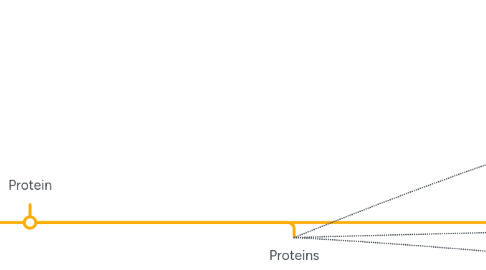
1. Importance of non polar amino acids
1.1. three dimensional strucutre due to hydrophobic interactions
1.2. Sickle cell anemia (replacement of 6th amino acid glutamate with valine at beta hemoglobin A)
2. Importance of polar amino acids
2.1. Hydrogen bond
2.2. SH of cysteine in enzyme active site
2.3. Disulfide to stabilize ex: albumin- insulin-imminoglobulins
3. Semi essential
4. Types of bonds in protein
4.1. Covalent
4.1.1. Amide bond
4.1.2. Di sulfide bond
4.2. non covalent
4.2.1. Hydrophobic interactions
4.2.2. Hydrogen bond
4.2.3. Electostatic interactions (ionic)
5. Conformation of protein
5.1. Primary
5.2. secondary
5.3. tertiary
5.4. quaternary
6. Shape of protein
6.1. Fibrous
6.2. Globular
7. enzymes classification according to reaction
7.1. Oxidoreductases
7.1.1. Oxidases
7.1.2. Hydroperoxidases
7.1.2.1. Catalase
7.1.2.2. G-SH Peroxidase
7.1.3. Dehydrogenases
7.1.3.1. NAD,NADP-dependent --> Lactate dehydrogenase
7.1.3.2. FMN,FAD-dependent --> Saccinate dehydrogenase
7.1.4. Oxygenases
7.1.4.1. Dioxygenase
7.1.4.2. Monooxygenase
7.1.5. Reductases
7.2. Transferrases
7.2.1. Aminotransferase
7.2.2. Transasylace
7.2.3. Transmethylase
7.3. Hydrolases
7.3.1. Esterases
7.3.2. Peptidases
7.3.3. Phosphatases
7.4. Lyases
7.4.1. Decarboxylases
7.4.2. Hydratases
7.4.3. Dehydratases
7.5. Isomerases
7.5.1. Racemases
7.5.2. Epimerases
7.5.3. Mutases
7.6. Ligases
7.6.1. Syntheatases
7.6.2. Carboxylases
8. Co factors
8.1. essential ions
8.1.1. Metal activating enzymes
8.1.2. Metalloenzymes
8.1.2.1. Carbonic anhydranse --> zn metalloenzymes
8.2. Co enzymes
8.2.1. co susbtrate
8.2.1.1. NADH.ATP
8.2.2. prothetic group
8.2.2.1. Flavin Adenine Dinucleotide
9. Metabolite enzymes
9.1. ATP
10. vitamin or vitamine dervied enzymes
11. enzyme specifity
11.1. Absolute
11.2. Relative
11.3. Group
11.4. Stereochemical
12. Regulation of enzymes
12.1. (Activity regulation) Short term - rapid - qualitative
12.1.1. induction
12.1.2. Repression
12.1.3. Degradation
12.2. (Amount regulation) Long term - slow - quantitative
12.2.1. Allosteric regulation
12.2.2. Feedback regulation
12.2.3. Covalent modification
12.2.3.1. Phoshorylation
12.2.4. Activation by cleavage
12.3. Compartmentation
13. Organic catalysts
13.1. Ribozymes
13.2. Enzymes
13.2.1. Simple protein enzymes
13.2.2. Conjugated protein enzymes (Holoenzymes)
13.2.2.1. Proteiin part
13.2.2.2. Non protein part
13.2.2.2.1. Co factors
14. Activators
14.1. allosteric regulation
14.1.1. AMP for phosphofructokinase 1 enzymes
14.2. Covalent modification
14.2.1. Phosphorylation
14.3. Pepetide cleavage
14.4. Keep -SH active by cofactors
14.4.1. Vitamin C for glyceraldehyde 3 P dehydrogenase enzymes
14.5. Ions as cofactors
14.5.1. Mg++ for kinases
15. Protein
15.1. Amino Acids
15.1.1. Primary Amino Acids
15.1.1.1. Polar
15.1.1.1.1. Nuetral
15.1.1.1.2. Acidic
15.1.1.1.3. Basic
15.1.1.2. non polar
15.1.1.2.1. Neutral
15.1.2. Derived Amino Acids
15.1.2.1. 4 hydroxyproline
15.1.2.2. 5 hydroxy lysine
15.1.2.3. cystine
15.1.3. Non protein Amino Acids
15.1.3.1. Beta Alanine
15.1.3.2. GABA
15.1.3.3. Dopa
15.1.3.4. Diiodotyrosine
15.2. Proteins
15.2.1. simple
15.2.1.1. protamines
15.2.1.2. histones
15.2.1.3. scleroproteins
15.2.2. Compound or conjugated
15.2.2.1. phosphoproteins
15.2.2.2. lipoproteins
15.2.2.3. glycoproteins
15.2.2.4. nucleoproteins
15.2.2.5. chromoproteins
15.2.2.6. metalloproteins
15.2.3. Derived
15.3. Peptides
15.3.1. L carnosine
15.3.2. Glutathione
15.3.3. Many hormones
16. Inhibitors
16.1. reversible
16.1.1. Competitive
16.1.2. Non competitive
16.2. Irreversible
16.2.1. Example: Iodoacetate reacts with -SH of glyceraldehyde 3 P dehydrogenase enzymes
17. Monosaccharide
17.1. Function group
17.1.1. Aldose
17.1.2. Ketose
17.2. Number of Carbon atoms
17.2.1. Triose
17.2.2. Pentose
17.2.3. Hexose
18. Isomers
18.1. D,L
18.2. a,B
18.3. Epimers
18.4. Aldose,Ketose
19. Disaccharide
19.1. Maltose
19.1.1. 2 D glucose -- a 1,4 glucosidic bond
19.2. Lactose
19.2.1. Galactose and glucose -- B 1,4 galactosidic bond
19.3. Sucrose
19.3.1. Fructose and glucose -- b 2,1 fructosidic bond
20. Polysaccharide
20.1. Homogenous
20.1.1. Glucosan
20.1.1.1. Starch
20.1.1.2. Glycogen
20.1.1.3. Cellulose
20.1.2. Fructosan
20.1.2.1. Inulin
20.2. Heterogenous
20.2.1. Neutral
20.2.2. Acidic (GAGs)
20.2.2.1. Sulphated
20.2.2.1.1. Hyaluronic acid
20.2.2.2. Not sulphated
20.2.2.2.1. Chondriotin
20.2.2.2.2. Dermatan
20.2.2.2.3. Heparan
20.2.2.2.4. Keratan
